Artificial Intelligence is undergoing a quiet but profound revolution. We’ve moved past the era of simple chatbots and reactive voice assistants like Siri. We are now entering the age of agentic AI—proactive, autonomous systems that can reason, plan, and act independently to achieve complex goals. Think less of a digital tool and more of a digital teammate.
This new wave of AI isn’t just a curiosity for tech enthusiasts; it’s already beginning to reshape the very fabric of our local communities. From the news you read over your morning coffee, to the street festival you discover for the weekend, to the daily commute you navigate, agentic AI is the invisible hand working to make local life more efficient, personalized, and connected. But this transformation comes with its own set of complex challenges.
This article explores the three pillars of this “Agentic City”: how AI is changing local news, curating local events, and optimizing local traffic. We’ll also look at the immense ethical questions we must confront to ensure this powerful technology builds a future that is not only smarter but also more equitable and trustworthy for everyone.The AI-Powered Newsroom: Efficiency Engine or Existential Threat?
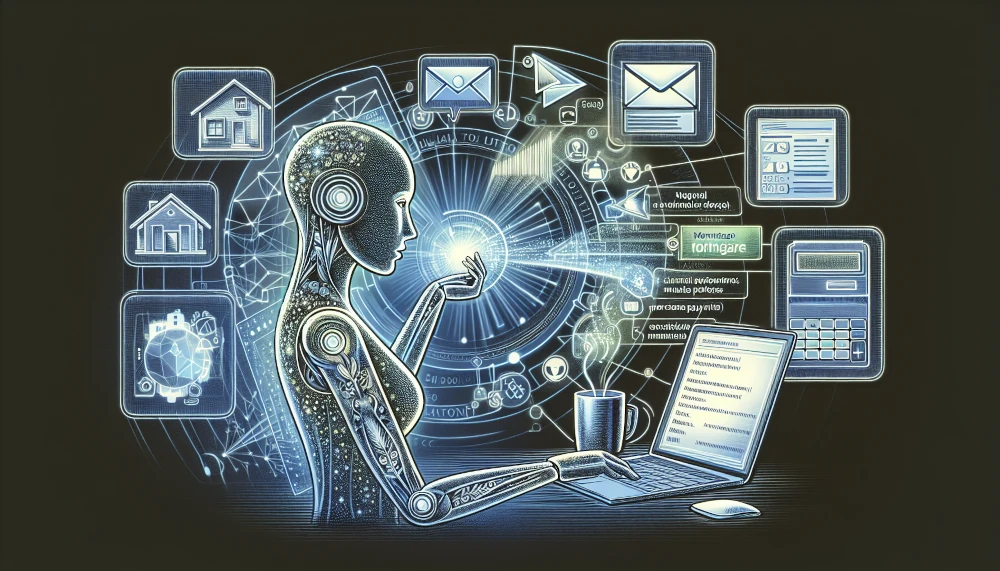
Local journalism, an industry already facing immense economic pressure, finds itself at a crossroads with agentic AI. These intelligent systems offer both a potential lifeline through incredible efficiency gains and a looming threat to traditional business models. The impact is a classic double-edged sword.
Automating the Grind, Freeing the Journalist
At its best, AI in the newsroom acts as a powerful force multiplier, automating the repetitive, time-consuming tasks that can bog down reporters. This allows journalists to dedicate their valuable time to what they do best: deep investigation, source building, and crafting compelling narratives.
- Transcription & Summarization: For decades, reporters spent countless hours transcribing interviews. Today, AI tools can do this with stunning accuracy in minutes. For example, the hyperlocal news platform Main Media in Bihar, India, used Google’s Pinpoint tool to transcribe Hindi-language audio with 90% accuracy, reducing a multi-hour task to just ten minutes. This dramatically expanded the small team’s reporting capacity.
- Data Analysis & Breaking News: Organizations like the Associated Press (AP) are at the forefront, using a suite of AI tools to automate the writing of basic corporate earnings reports and public safety alerts. Other platforms, like Dataminr, function as an early warning system. By scanning billions of public data points from nearly a million sources, its AI agents can detect the earliest signals of a breaking news event, giving journalists a critical head start.
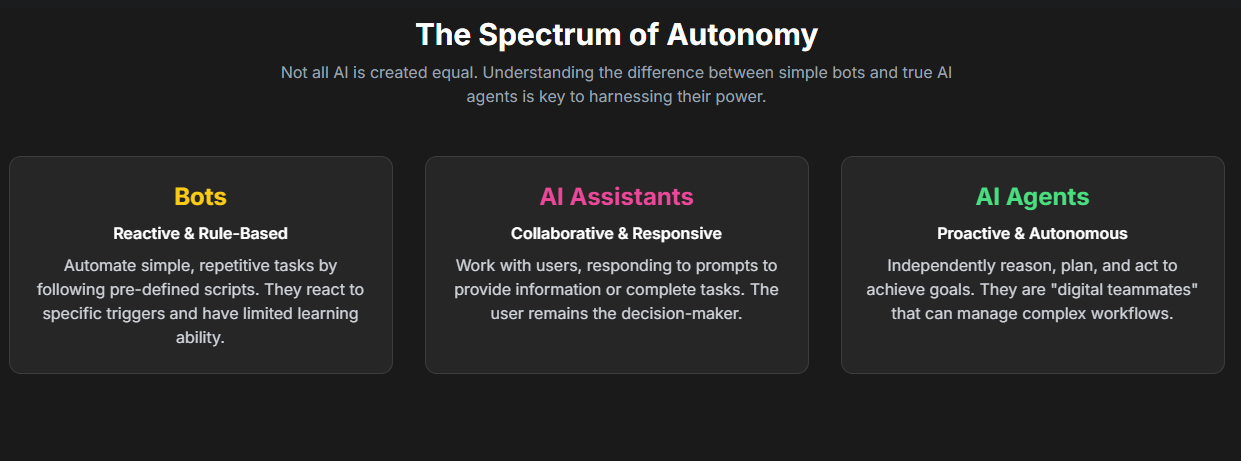
This automation frees journalists from the grind, empowering them to tackle more ambitious stories that hold power to account and serve the community.
Auditing for Equity and Uncovering Blind Spots
Beyond mere production, AI is giving newsrooms powerful tools for introspection. A groundbreaking example comes from THE CITY, a nonprofit newsroom in New York. They launched a project to audit four years of their own coverage using AI. By processing thousands of articles and extracting geographic data, they created an interactive map that visualized their reporting patterns across the city’s diverse neighborhoods.
The results were revealing. The map showed which communities were receiving extensive coverage and, more importantly, which were being overlooked, such as parts of Staten Island. This data-driven insight sparked critical internal conversations about resource allocation and journalistic mission, pushing the newsroom to serve all communities more equitably. This is a sophisticated use of AI—not just to create news, but to analyze its own impact.
The Peril: When AI Summaries Kill the Click
While the internal benefits are clear, an external threat looms large. The rise of AI-powered search features, like Google’s AI Overviews, poses what many publishers consider an existential threat. These tools generate a summary of information at the very top of the search results page, directly answering a user’s query.
Why is this a problem? If a user gets the answer they need from the AI summary, they have no reason to click through to the original news article. For local news outlets that depend on website traffic for advertising revenue, this is a potential catastrophe. One analysis found that a news site could lose as much as 79% of its click-through traffic for a query if it appears below an AI overview.
This creates a painful irony: the same technology that helps newsrooms create content more efficiently is being used by tech platforms to siphon away the audience and revenue needed to fund that journalism in the first place. This dynamic is forcing a rapid, and difficult, pivot in the industry away from ad-based models and toward direct reader support.
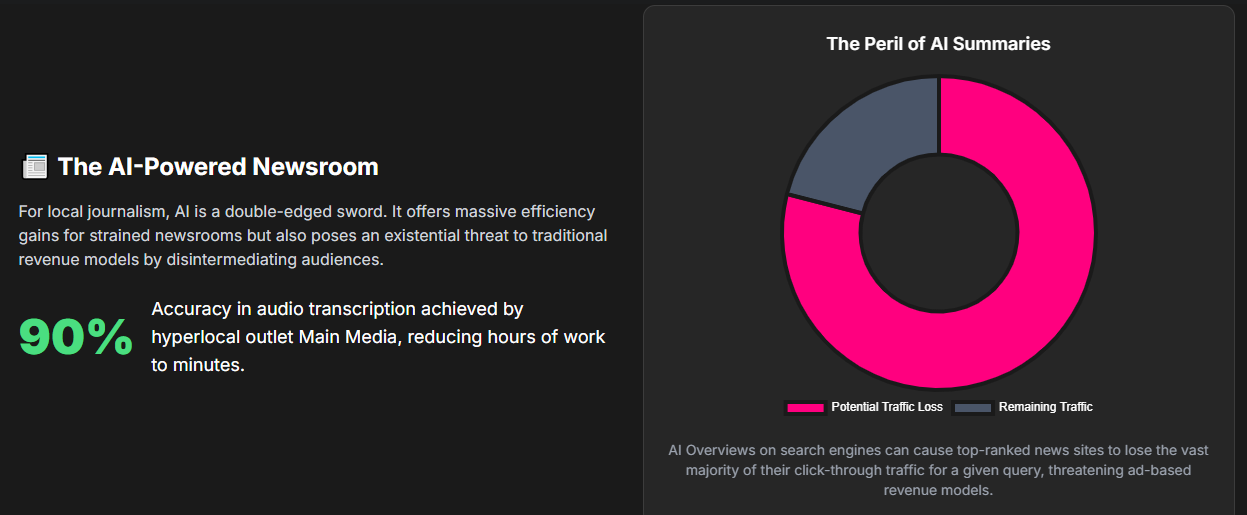
The Hyper-Personalized City: AI as Your Social and Transit Concierge
Agentic AI is also changing how we experience our cities, transforming reactive searching into proactive discovery for everything from community events to our daily commute.
From Reactive Search to Proactive Discovery
Think about how you typically find local events. You might search a few websites, scroll through social media, or check a community calendar. It’s a reactive process that requires you to do all the work.
AI agents are flipping this model on its head. By aggregating event data from countless sources and learning your unique preferences—your past attendance, stated interests, location, and even the time of day you’re most active—these systems can act as a personal curator for your social life. The goal is to move from a user-initiated search to an agent-initiated discovery, presenting you with a perfectly tailored list of concerts, markets, or workshops before you even think to look.
For event organizers, this is a game-changer. AI can help automate marketing by generating compelling event descriptions and social media posts, driving higher attendance and boosting the vibrant local economy. However, this also positions these AI platforms as powerful new gatekeepers of local culture, with the potential to favor larger, paid events over smaller, community-run gatherings.
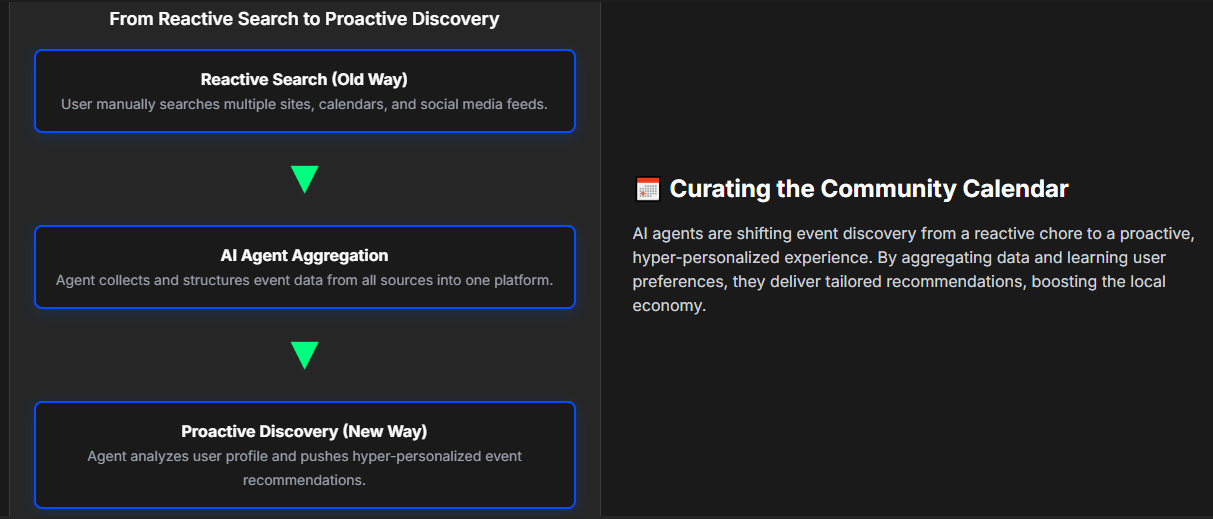
The Intelligent Street: AI Tackles Traffic Jams
Perhaps the most mature application of agentic AI in the urban domain is in traffic management. Cities are moving away from the expensive, static solution of building more roads and are instead investing in dynamic, intelligent systems to optimize the roads they already have.
This is accomplished by fusing several key technologies:
- Computer Vision: AI-powered cameras analyze video feeds to count vehicles, monitor pedestrian flow, and instantly detect accidents or disabled cars.
- Predictive Analytics: By analyzing historical and real-time data, machine learning models can forecast traffic congestion before it happens.
- Real-Time Data Processing: The system ingests live data from cameras, road sensors, and connected vehicles to make split-second adjustments.
The results are already impressive.
- In cities like Kaohsiung, Taiwan, an AI system built on NVIDIA’s platform analyzes thousands of camera feeds to understand complex events like flash floods, reducing incident response times by up to 80%.
- In Pittsburgh, an AI-powered system that adjusts traffic signals in real time cut vehicle travel times by 25% and significantly reduced idling.
- Boston collaborated with Google on Project Green Light, using AI to optimize traffic signal timings and reduce congestion.
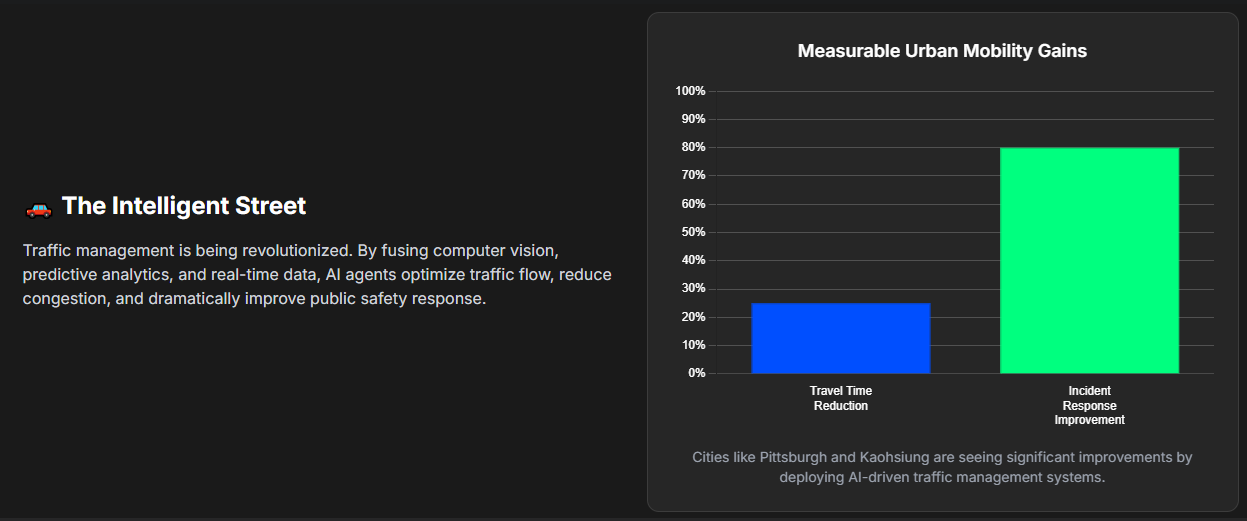
This technology transforms traffic management from a reactive discipline (responding to a crash report) into a predictive one, preventing bottlenecks before they even form.
The Civic Partner: Governance, Ethics, and the Road Ahead
The potential of agentic AI extends far beyond these specific areas, promising to act as a “digital teammate” for local government itself. But to harness this power responsibly, we must first navigate a labyrinth of ethical challenges.
A 24/7 Digital Front Desk for City Hall
Imagine reporting a pothole and an AI agent instantly logs your request, uses your phone’s location to pinpoint the issue, assigns a ticket to the public works department, and provides you with a tracking number—all in a matter of seconds. This is the “24/7 Digital Front Desk.”
Even more transformative is the potential for proactive service delivery. By analyzing data across siloed departments (with citizen permission), an agent could identify a resident who is eligible for a utility assistance program or a childcare subsidy and proactively reach out to help them apply. This shifts government from a reactive system that waits for requests to a proactive partner that anticipates needs.

The Governance Imperative: Bias, Privacy, and Accountability
This power comes with profound responsibility. For these systems to earn public trust, we must confront the risks head-on.
- Algorithmic Bias: AI models are trained on historical data. If that data reflects past discriminatory practices (e.g., in housing or law enforcement), the AI will learn and amplify those biases at scale, systematically disadvantaging marginalized communities.
- Data Privacy: Smart cities run on data. The vast network of sensors, cameras, and apps required for agentic AI creates an unprecedented potential for mass surveillance, creating a chilling effect on civil liberties if not properly governed.
- Accountability: If an autonomous agent denies someone a benefit or makes a critical error, who is responsible? The “black box” nature of some AI models makes it difficult to understand their reasoning, posing a major challenge to due process and accountability.
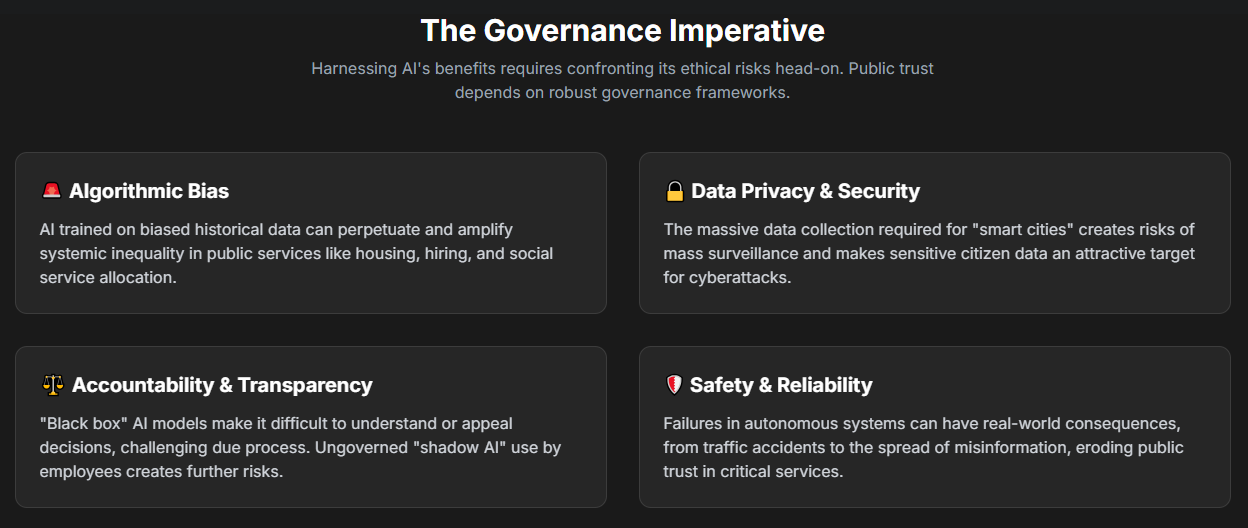
To mitigate these risks, there are no easy answers. It requires a steadfast commitment to human-in-the-loop oversight for high-stakes decisions, rigorous auditing of data and algorithms, and the creation of strong public AI governance frameworks before these technologies are widely deployed.
Building a Trustworthy Agentic City
Agentic AI is no longer a futuristic concept; its building blocks are here, and its deployment is accelerating. It offers a future where our local communities are more efficient, responsive, and intelligently designed.
This future, however, is not inevitable. It must be built with intention. The immense potential of agentic AI will not be realized through technology alone, but through deliberate, human-centered choices. By demanding transparency, establishing robust ethical guardrails, and fostering democratic accountability, we can harness the power of these intelligent systems to build cities that are not only smarter, but also more just, equitable, and trustworthy for all.


